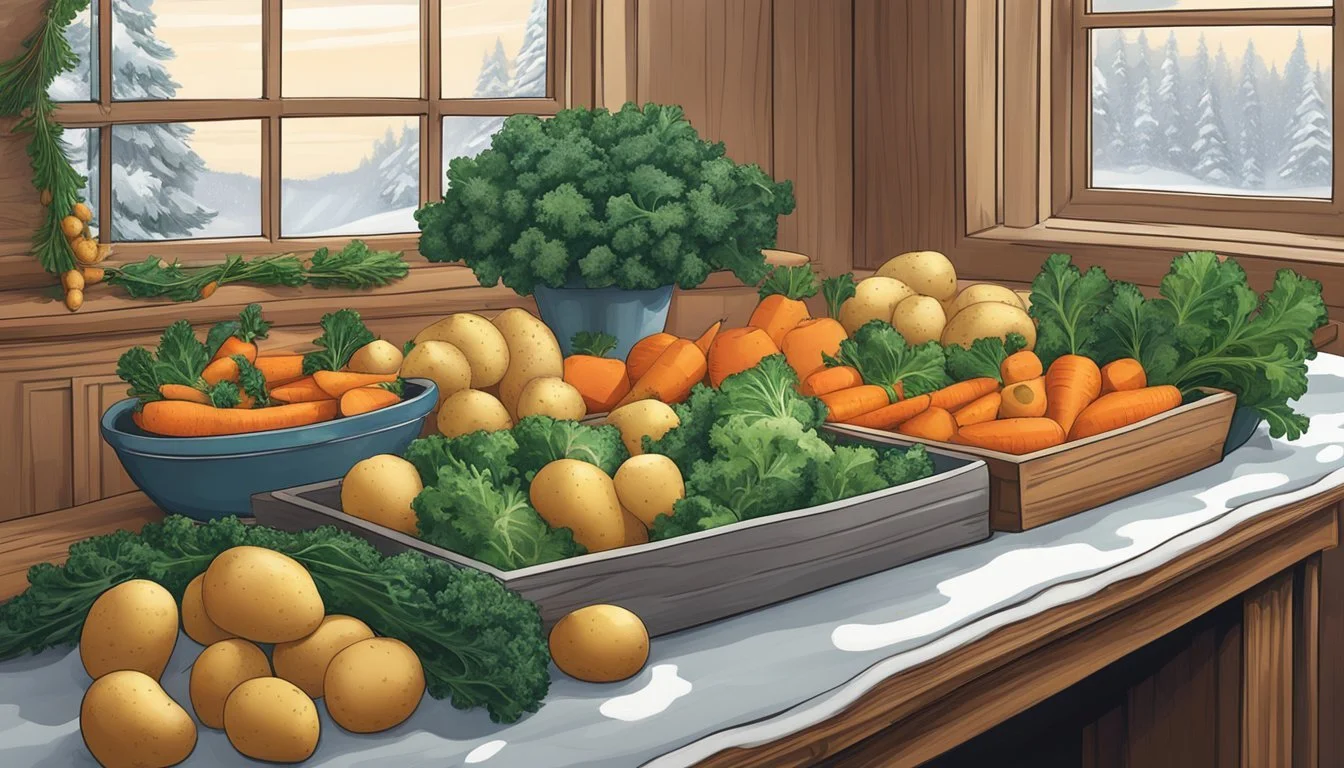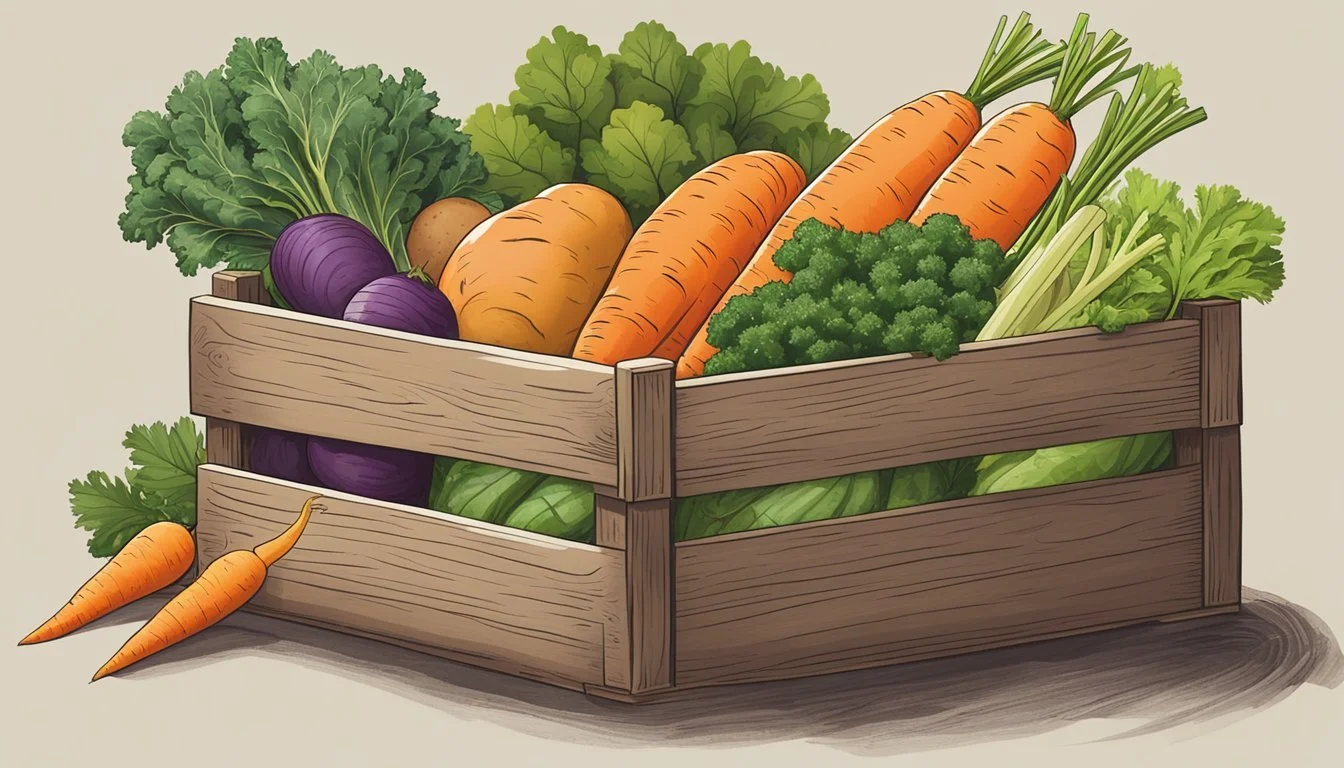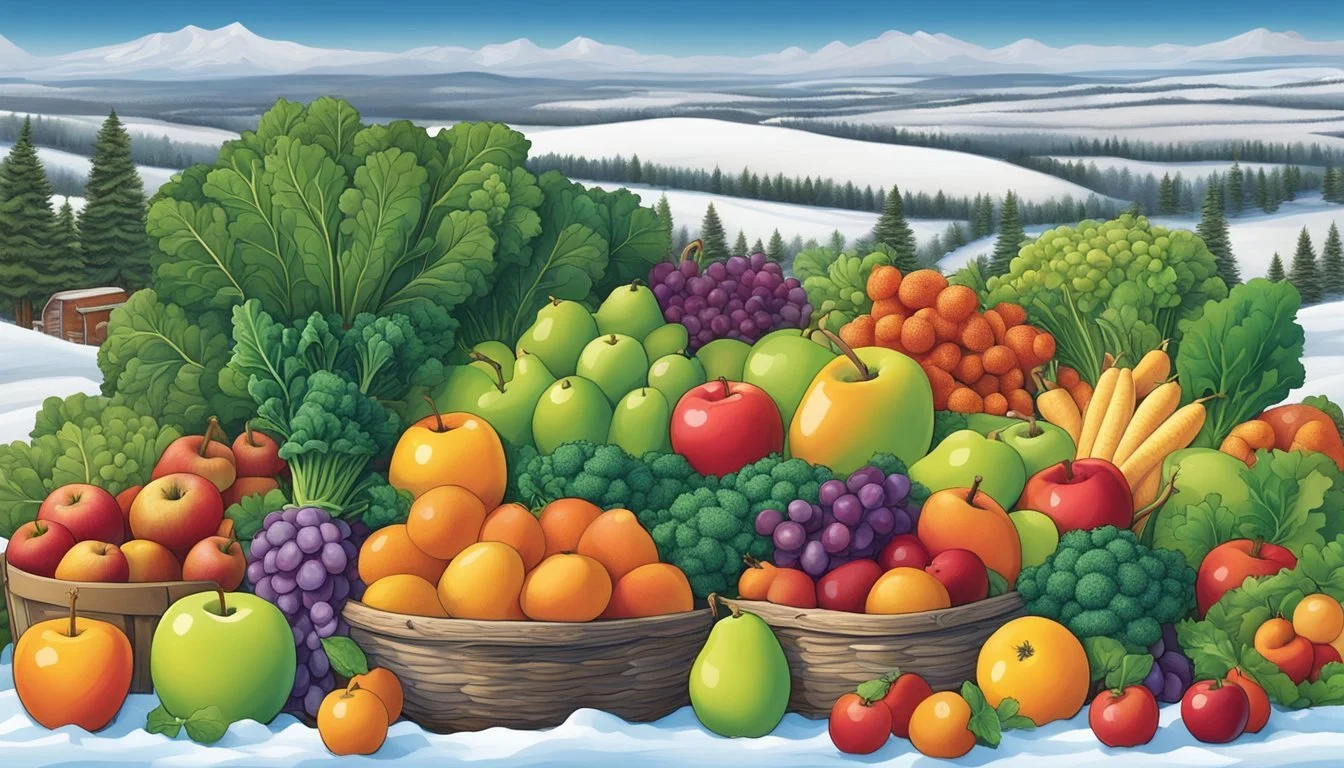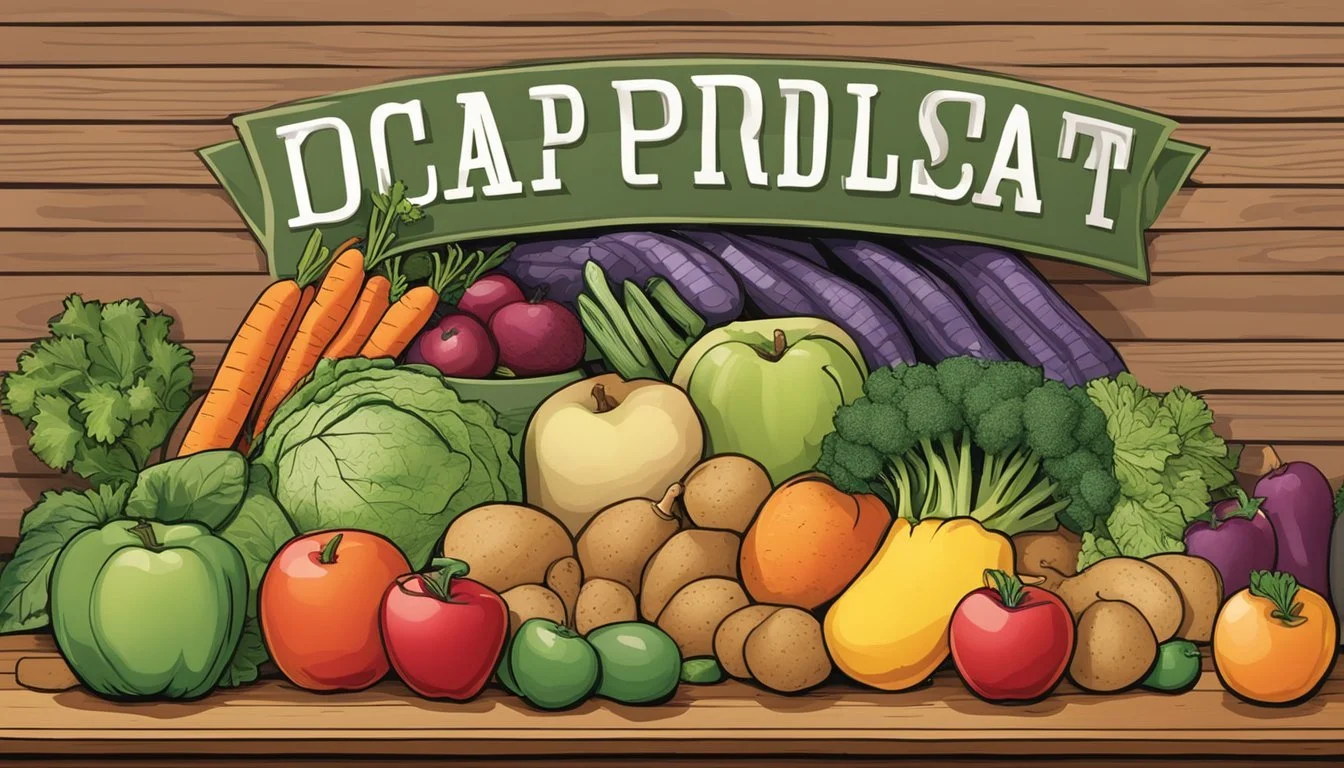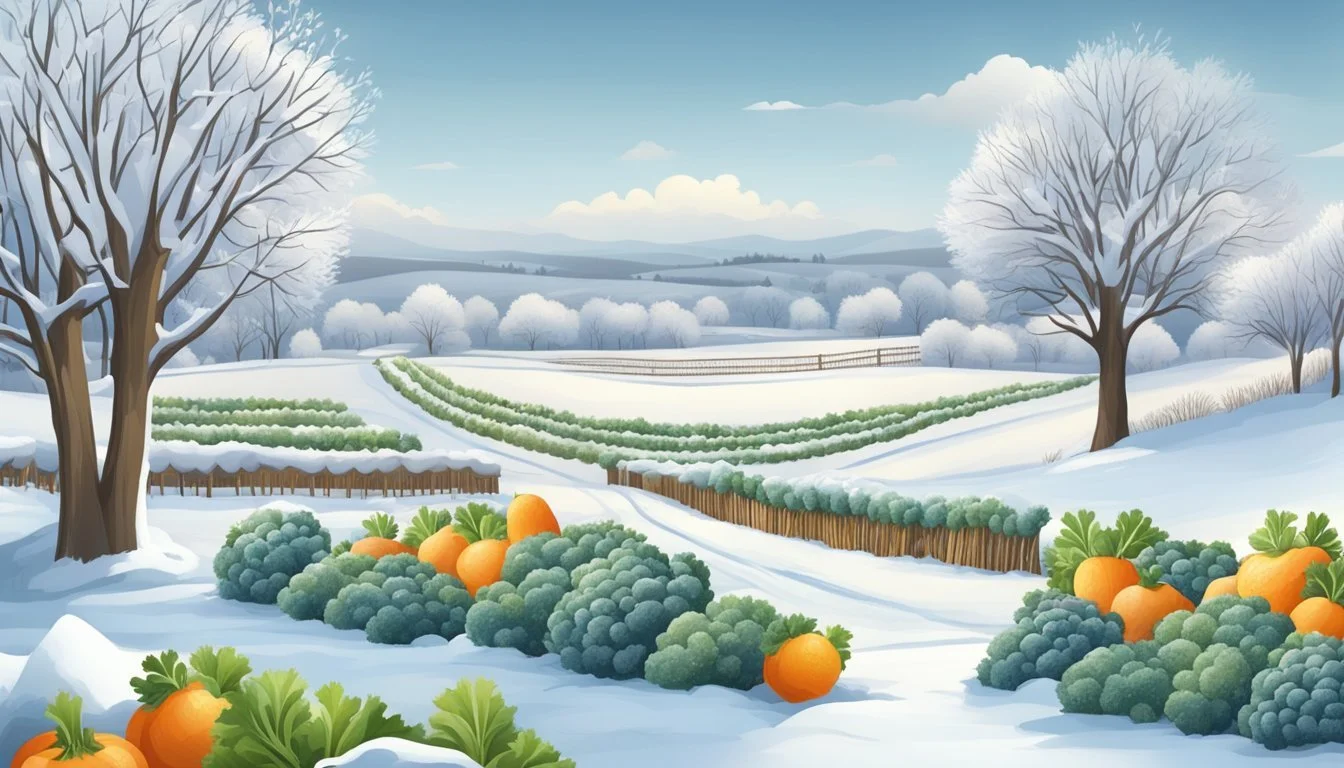Nebraska Seasonal Fruit & Vegetables Guide in January
What's Fresh?
This Article is Part of our Nebraska Seasonal Fruit & Veg Calendar
In Nebraska, January offers a diverse bounty in the realm of fruits and vegetables despite the chill that blankets the state. With the agricultural sector adapting to seasonal changes, consumers can enjoy a variety of produce that is both flavorful and nutritious. Fruit options such as apples, grapefruit, and kiwi remain readily available, bringing sweetness and a burst of vitamins to the wintry days.
The selection of January vegetables in Nebraska is robust, featuring hearty winter staples. Shoppers can find brussels sprouts, cabbage, and cauliflower (how long does cauliflower last?); these vegetables not only withstand the cold months but also provide essential nutrients and opportunities for a wide range of comforting dishes. Lettuce and green peppers are also on the menu, allowing for fresh salads and sides that complement the heavier winter fare.
While some produce is stored from previous harvests, Nebraska's food system ensures that the available fruits and vegetables retain their quality. This allows for a sustainable consumption pattern and supports local agriculture during a month when fields are often dormant. The commitment to providing seasonal produce ensures that Nebraskans have access to fresh, healthy food options all year round.
Understanding Nebraska's Growing Season
Nebraska's winters impose specific conditions on what can be grown during this season, influencing both crop selection and agricultural practices. The state's growers adapt to these conditions to ensure a continuous supply of produce even in the colder months.
Winter Climate and Crop Selection
In Nebraska, the winter climate is characterized by cold temperatures and shorter daylight hours, presenting challenges for crop growth. Despite these conditions, certain cool weather crops are well-suited to the winter growing season. They include spinach, kale, and some varieties of lettuce and root vegetables, which can often withstand the colder temperatures.
Cool weather crops suitable for Nebraska:
Spinach
Kale
Lettuce varieties
Root vegetables (e.g. carrots (how long do carrots last?), beets)
These crops are typically planted towards the end of the previous growing season or protected under cover to extend their productivity through the winter months.
January Specifics: Weather Impact on Produce
During January, Nebraska's weather contributes to the limited availability of fresh produce. Temperatures often drop below freezing, making it imperative for farmers to use protective measures such as greenhouses or high tunnels to shelter sensitive crops.
Weather impacts on produce in January:
Below freezing temperatures
Decreased daylight
Potential for snow and frost
Producers must monitor weather patterns vigilantly to protect crops against winter extremes, utilizing strategies like mulching to insulate the soil and selecting hardier crop varieties that can tolerate the stress of cold weather. As a result, the January offerings at local markets are mostly storage crops from the previous season and those that can be grown in controlled environments.
Seasonal Fruits Available in January
January in Nebraska sees a variety of fruits in season, primarily highlighted by the peak availability of citrus fruits and the continued accessibility of stored fruits like apples and pears. These fruits offer a refreshing balance of sweet and sour flavors to brighten the winter palate.
Citrus Fruits Peaks
In January, citrus fruits reach their peak, providing vibrant flavors that range from sweet to tangy. Consumers can enjoy a selection of:
Oranges: Known for their sweet and juicy segments.
Grapefruit: Offers a bittersweet profile that's both refreshing and slightly tart.
Lemons: Renowned for their zesty and sour taste, perfect for culinary uses.
Limes: Smaller in size but packed with a tangy punch that enhances both sweet and savory dishes.
These citrus fruits not only add a burst of flavor to meals but are also packed with vitamin C, which is essential during the colder months.
Stored Fruits Accessibility
While fresh summer picks are out of season, stored fruits such as apples and pears remain readily available. Storage technologies allow these fruits to be consumed throughout winter while maintaining their flavor profile, which tends toward the sweet and sometimes slightly tangy side. Available varieties may include:
Apples: A versatile fruit that retains its sweet taste and crisp texture.
Pears: Offer a sweet and buttery smooth experience, with some varieties presenting a slightly tangy flavor.
These fruits provide a comforting and familiar sweetness that contrasts well with the zesty citrus fruits also in season.
Seasonal Vegetables Available in January
In January, Nebraska's cold climate favors the harvest of robust root vegetables and hearty greens, which can withstand the winter's chill and even benefit in flavor after a frost.
Root Vegetables Prime Time
In the heart of winter, root vegetables are at their prime in Nebraska. Carrots, parsnips, and beets (how long do beets last?) are particularly sweet, having converted starches into sugars to survive the frost. Turnips and rutabagas offer a slightly peppery taste and are versatile for a variety of dishes. Leeks, with their mild onion-like flavor, are also widely available and perfect for adding depth to winter soups and stews. Celeriac, or celery root, is harvested for its distinctive, earthy flavor and can be mashed or used in hearty casseroles.
Carrots: Sweet, crunchy, good for roasting or raw snacks
Parsnips: Nutty flavor, great in soups or roasted
Beets: Earthy taste, can be roasted, boiled, or pickled
Rutabagas: Slightly sweet, perfect for mashing or roasting
Turnips: Can be used in soups or roasted, with a peppery punch
Leeks: Mild, onion-like, ideal for soups and sautéing
Celeriac: Earthy, nutty taste, versatile for stews and gratins
Hearty Greens Harvest
January also sees a harvest of hearty greens. Kale and collards are in season and known for their health benefits and hearty flavors. The colder temperatures even enhance their taste, reducing bitterness and bringing out a slightly sweeter profile. These greens are excellent for sautés, soups, and stews.
Kale: Robust flavor, slightly sweetened by frost, versatile for salads and cooking
Collards: Rich in nutrients, milder taste when cooked, ideal for longer simmering dishes
Health Benefits of Seasonal Produce
Eating seasonal fruits and vegetables in Nebraska during January offers numerous health benefits. These foods are typically harvested at their peak, which can lead to higher nutrient content — a key factor in maintaining a healthy diet.
Seasonal Fruits: Rich in Vitamin C and other antioxidants, fruits such as apples and pears provide immune system support, especially crucial during the colder months. Consuming seasonal fruits ensures individuals receive a variety of nutrients.
Vegetables: Root vegetables like carrots and sweet potatoes, common in January, are packed with vitamins and minerals. They can contribute to a well-balanced diet and support bodily functions, from vision to the immune response.
Nutrient Highlights
Vitamin C: Found abundantly in fruits; supports the immune system.
Fiber: Present in both fruits and vegetables; aids in digestion and satiety.
Potential Health Outcomes
Immunity Boost: Increased vitamin intake can strengthen the body's defenses.
Reduced Inflammation: Antioxidants from fruits and vegetables help reduce bodily inflammation.
Liver Cleansing: Certain produce like beets assist in detoxifying the liver.
Consuming seasonal produce also ensures a lower carbon footprint due to reduced transportation requirements and supports local economies. People who eat seasonally are likely to experience a more diverse diet throughout the year, potentially reducing the risk of chronic diseases and improving overall health.
Locally Sourced Produce
January in Nebraska showcases the resilience of local agriculture, with farmers providing fresh, locally-sourced produce despite the cold weather. Availability is sustained through various community-supported initiatives.
Farmer's Markets
In Nebraska, farmer's markets during January might feature produce like stored root vegetables and hardy greens. Several city markets offer winter hours, providing residents with access to local farmers' recent harvests. The following table lists some typically available produce at Nebraska's farmer's markets during this month:
Available Produce Farmer's Market Location Winter Squash Lincoln Potatoes Omaha Cabbage Grand Island Carrots Kearney
These markets support the local economy and ensure that fresh produce is an option for consumers.
Community Supported Agriculture (CSA)
Community Supported Agriculture (CSA) programs in Nebraska enable consumers to purchase shares of a farm's harvest in advance. Throughout January, Nebraskans receive seasonal selections directly from the producers. While fresh, field-grown fruits and vegetables are sparse, many CSAs provide items like:
Apples: Stored from fall harvest
Beets: Often available from winter storage
Onions: A staple, often from controlled storage
Greenhouse-grown Herbs: Such as parsley or cilantro
CSAs in Nebraska nurture a direct link between farmers and consumers, fostering a mutual commitment to the region's food system's sustainability and resilience during the winter months.
Cooking and Preparing Seasonal Produce
In January, Nebraska's chill necessitates a creative spin on the use of locally available fruits and vegetables to maintain a flavorful and nutritious diet. One harnesses the peak flavors of produce by cooking them in ways that complement their natural profiles.
Brussels sprouts, a hardy winter vegetable, find new life beyond just boiling. They can be roasted with a drizzle of olive oil and a sprinkle of sea salt (how long does sea salt last?) to enhance their nutty essence. Alternatively, they can be shredded into salads, providing a crisp texture and a slightly sweet flavor when raw.
Root vegetables, such as carrots and sweet potatoes, are also in abundance. These can be roasted, steamed, or mashed. Incorporating herbs like rosemary or thyme can accentuate their earthy flavors. (What wine goes well with earthy flavors?) One may even caramelize these vegetables to add a depth of flavor to winter dishes.
Here is a simple tabulation of preparation methods aligned with seasonal produce to maximize flavor:
Produce Preparation Method Flavors Enhanced Brussels Sprouts Roasted or Shaved for Salads Nutty, Sweet Carrots Roasted, Steamed, or Pureed Sweet, Earthy Sweet Potatoes Baked, Mashed, or Caramelized Sweet, Rich
To conclude, when cooking Nebraska's seasonal produce in January, techniques should focus on developing deeper, richer flavors to complement the hearty needs of winter recipes while ensuring the integrity of the produce's natural taste is preserved. This sustains both palatability and nutritional value for those enjoying the season's offerings.
Preservation and Storage of Seasonal Produce
In Nebraska, the availability of fresh produce fluctuates with the seasons. During January, options may be limited, but proper preservation and storage extend the life of available vegetables. Emphasizing storage methods is crucial in ensuring both quality and nutritional value.
Cold Storage: Certain vegetables like root crops can be stored in cold, humid conditions. A cellar or a fridge can maintain a 32°F to 40°F range, which is ideal for these types.
Carrots
Beets
Turnips
Dry Storage: Onions and garlic prefer a cool, dry place. They require good air circulation, and a pantry or garage that stays between 50°F to 60°F with low humidity is adequate.
Freezing: Freezing is an effective way to preserve many types of produce. To retain texture and flavor, blanch vegetables before freezing. This halts enzyme activity that causes spoilage.
Blanching times for common January vegetables in Nebraska:
Vegetable Blanching Time (in minutes) Broccoli 3 Brussels Sprouts 4 Spinach 2
Canning: Canning is a method that can be used for tomatoes, which are occasionally available from indoor growers. Acidic foods like tomatoes are suitable for water-bath canning, while non-acidic vegetables require pressure canning.
Nebraska's residents leverage these methods to enjoy local produce throughout the challenging winter months. By doing so, the consumption of in-season vegetables is maximized, supporting local agriculture and ensuring a supply of nutritious food.
Supporting Local Nebraska Agriculture
January in Nebraska may present challenges for agriculture due to the cold climate, but it offers unique opportunities to support local growers. By choosing to buy local, consumers can contribute to the agricultural economy of the state and ensure the sustainability of food systems.
Local farms in Nebraska utilize season extension techniques, such as hoophouses, to grow produce during the winter months. This means that even in January, consumers can access fresh, locally-grown produce. The benefits are twofold: it reduces the carbon footprint associated with transporting food long distances and bolsters the local economy.
Nebraska's Local Produce in January:
Winter greens
Storage crops (such as root vegetables)
Meats
Mushrooms
Ways to Support Nebraska Farmers:
Shop at local farmers markets or through community-supported agriculture (CSA) programs.
Purchase meats and other products direct from Nebraska ranchers.
Engage with local food initiatives like Buy Fresh Buy Local® Nebraska.
Seek Nebraska-grown produce at grocery stores, asking for it if not readily available.
Supporting farmers in Nebraska not only nourishes the local community but also helps maintain farming as a viable livelihood in the state. When residents purchase local foods, they invest in the United States' agricultural infrastructure, ensuring that Nebraska's rich farming heritage continues to thrive in a modern economy.
Conclusion
Nebraska's January climate plays a pivotal role in determining the availability of fruits and vegetables. Despite the cold weather, consumers can find a variety of produce. Winter-hardy vegetables such as cabbage, kale, and spinach thrive in these conditions, while broccoli, cauliflower, onions, and radishes are also typical. They form part of the cool-season planting category, which adapts well to lower temperatures.
Early in the year, root vegetables like potatoes and peas can be available, thanks to their ability to be stored from harvests during the growing season or cultivated in controlled environments. While fresh fruit options are limited in January, storage crops such as apples remain accessible post-harvest into the winter months.
Here is a brief list of produce consumers might find in Nebraska during January:
Vegetables:
Cabbage
Kale
Spinach
Broccoli
Cauliflower
Onions
Radishes
Potatoes
Peas
Fruits:
Apples (from storage)
Though the selection of fruits is sparse in this month, Nebraska’s selection of available vegetables remains robust, offering nutrition and variety to residents and visitors alike. Access to these seasonal offerings is facilitated through local farmers' markets and stores that prioritize local, in-season produce. This ensures that the quality of the produce is at its peak, affording consumers with fresh, nutrient-dense options even in the colder months.

